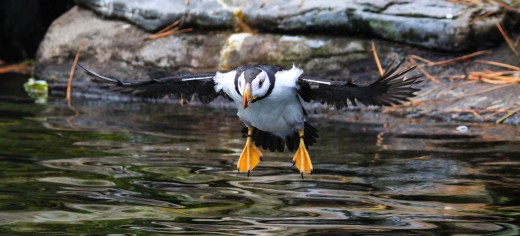Horned Puffins Stretch Their Wings at the Oregon Coast Aquarium
Newport, Oregon A new species of the feathered kind debuted at the Oregon Coast Aquarium early Tuesday morning when three horned puffins waddled out of their carrier into the Seabird Aviary.

This is the first time the Aquarium has exhibited horned puffins, known as Fratercula corniculata in the scientific community. These birds needed a home after a U.S. Fish & Wildlife Service seizure, and the Aquarium was glad to open its Seabird Aviary to them.
Carrie Lewis, President/CEO of the Aquarium explained, The Aquarium is happy to provide a permanent home for these important ambassadors of their species in their time of need.
The horned puffins will share the Aquariums Seabird Aviary, which is one of the largest outdoor aviaries in North America, with black oystercatchers, common murres, pigeon guillemots, rhinoceros auklets and tufted puffins. To maintain a balanced population between different species, the Aquarium is currently coordinating with the Alaska SeaLife Center to adopt a few of their horned puffin chicks that will hatch later this year.
The two females and one male are juveniles, meaning they are not downy pufflings anymore, but are not quite adults yet either. They did not develop full breeding plumage this season and will not be interested in mating for at least one more year.
Horned Puffins can live to be over 20 years old, so the Aquariums three new feathered friends will be a fixture in the Seabird Aviary for decades to come.
Like the other members in its taxonomic family, Alcidae, horned puffins evolved to fly underwater and in the air. The birds soar through water, diving up to 80 feet deep, to hunt for small fish, squid and crustaceans. To take off into the air puffins need a good runway, but once aloft their rapidly beating wings propel them as fast as 40 miles per hour!
In the wild, horned puffins spend most of the year out on the open sea diving for fish and bobbing on the oceans surface. They only come to land to breed on talus slopes and cliff faces, and occasionally in burrows on remote islands from northwest Alaska down to the southern border of British Colombia. The birds then migrate south for winter to the offshore waters of Washington, Oregon and even California. Although they are not listed as a species of concern, horned puffins are the least common of the puffin species.
CJ McCarty, Curator of Birds for the Aquarium, said, We are excited to add this adorable species to our Seabird Aviary. We look forward to providing the public a unique chance to learn about these wonderful birds and to see them up close!
Source: Oregon Coast Aquarium News Release
Photos by Brent_McWhirter

This is the first time the Aquarium has exhibited horned puffins, known as Fratercula corniculata in the scientific community. These birds needed a home after a U.S. Fish & Wildlife Service seizure, and the Aquarium was glad to open its Seabird Aviary to them.
Carrie Lewis, President/CEO of the Aquarium explained, The Aquarium is happy to provide a permanent home for these important ambassadors of their species in their time of need.
The horned puffins will share the Aquariums Seabird Aviary, which is one of the largest outdoor aviaries in North America, with black oystercatchers, common murres, pigeon guillemots, rhinoceros auklets and tufted puffins. To maintain a balanced population between different species, the Aquarium is currently coordinating with the Alaska SeaLife Center to adopt a few of their horned puffin chicks that will hatch later this year.
The two females and one male are juveniles, meaning they are not downy pufflings anymore, but are not quite adults yet either. They did not develop full breeding plumage this season and will not be interested in mating for at least one more year.
Horned Puffins can live to be over 20 years old, so the Aquariums three new feathered friends will be a fixture in the Seabird Aviary for decades to come.
Like the other members in its taxonomic family, Alcidae, horned puffins evolved to fly underwater and in the air. The birds soar through water, diving up to 80 feet deep, to hunt for small fish, squid and crustaceans. To take off into the air puffins need a good runway, but once aloft their rapidly beating wings propel them as fast as 40 miles per hour!
In the wild, horned puffins spend most of the year out on the open sea diving for fish and bobbing on the oceans surface. They only come to land to breed on talus slopes and cliff faces, and occasionally in burrows on remote islands from northwest Alaska down to the southern border of British Colombia. The birds then migrate south for winter to the offshore waters of Washington, Oregon and even California. Although they are not listed as a species of concern, horned puffins are the least common of the puffin species.
CJ McCarty, Curator of Birds for the Aquarium, said, We are excited to add this adorable species to our Seabird Aviary. We look forward to providing the public a unique chance to learn about these wonderful birds and to see them up close!
Source: Oregon Coast Aquarium News Release
Photos by Brent_McWhirter
